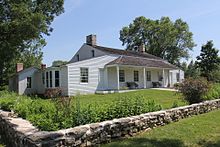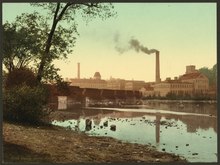History of Wisconsin
The retreating glaciers left behind a tundra in Wisconsin inhabited by large animals, such as mammoths, mastodons, bison, giant beaver, and muskox.
In 1634, Samuel de Champlain, governor of New France, sent Nicolet to contact the Ho-Chunk people, make peace between them and the Huron and expand the fur trade, and possibly to also find a water route to Asia.
[19] Nicolas Perrot, French commander of the west, established Fort St. Nicholas at Prairie du Chien, Wisconsin in May, 1685, near the southwest end of the Fox-Wisconsin Waterway.
Charles Michel de Langlade is generally recognized as the first settler, establishing a trading post at Green Bay in 1745, and moving there permanently in 1764.
On June 27, 1827, a Winnebago war band led by Chief Red Bird and the prophet White Cloud (Wabokieshiek) attacked a family of settlers outside of Prairie du Chien, killing two.
The Black Hawk War ended with the Battle of Bad Axe on August 1–2, with over 150 Native Americans dead and 75 captured and only five killed in the United States forces.
Milwaukee, along with Sheboygan, Manitowoc, and Kewaunee, can be traced back to a series of trading posts established by the French trader Jacques Vieau in 1795.
In the 1830s, he formed a partnership with Green Bay lawyer Morgan Martin, and the two men bought 160 acres (0.6 km2) of land between Lake Michigan and the Milwaukee River.
Meanwhile, an Ohio businessman named Byron Kilbourn began to invest in the land west of the Milwaukee River, forming the settlement of Kilbourntown.
Numerous other suggestions for the location of the capital were given representing nearly every city that existed in the territory at the time, and Governor Dodge left the decision up to the other lawmakers.
The legislature accepted a proposal by James Duane Doty to build a new city named Madison on an isthmus between lakes Mendota and Monona and put the territory's permanent capital there.
Turner's view was that American democracy, "involved widespread participation in the making of decisions affecting the common life, the development of initiative and self-reliance, and equality of economic and cultural opportunity.
"[43] Curti found that from 1840 to 1860 in Wisconsin the poorest groups gained rapidly in land ownership, and often rose to political leadership at the local level.
It banned commercial banking, granted married women the right to own property, and left the question of African-American suffrage to a popular vote.
Shortly after this, other railroad companies completed their own tracks, reaching La Crosse in the west and Superior in the north, spurring development in those cities.
On March 20, 1854, the first county meeting of the Republican Party of the United States, consisting of about thirty people, was held in the Little White Schoolhouse in Ripon, Wisconsin.
A mob of 5,000 people led by Milwaukee abolitionist Sherman Booth, himself a "Yankee" transplant from rural New York,[49] sprung Glover from jail and helped him escape to Canada via the underground railroad.
Some Wisconsin farmers responded by experimenting with crop rotation and other methods to restore the soil's fertility, but a larger number turned to alternatives to wheat.
The construction of railroads allowed loggers to log year round, after rivers froze, and go deeper into the forests to cut down previously unshippable wood supplies.
The logging companies sold their land to immigrants and out of work lumberjacks who hoped to turn the acres of pine stumps into farms, but few met with success.
It's no surprise Wisconsin's western region was once the site of volcanic eruptions so it makes sense that minerals that weren't commonly found in other parts of the state would be present here.
[69] Between 1901 and 1911, Progressive Republicans in Wisconsin created the nation's first comprehensive statewide primary election system,[70] the first effective workplace injury compensation law,[71] and the first state income tax,[72] making taxation proportional to actual earnings.
[74][75][76][77] As the war raged on in Europe, Robert M. La Follette, leader of the anti-war movement in Wisconsin, led a group of progressive senators in blocking a bill by president Woodrow Wilson which would have armed merchant ships with guns.
[80] University economics professors John R. Commons and Harold Groves enabled Wisconsin to create the first unemployment compensation program in the United States in 1932.
[82] The Stalwarts counterattacked by arguing if the university became embedded in the state, then its internal affairs became fair game, especially the faculty preference for advanced research over undergraduate teaching.
[84][85] Following Robert La Follette's death, his two sons assumed control of the Wisconsin Republican Party after a brief period of intraparty factional disputes.
Despite its popularity the party eventually declined as Philip, engulfed in scandal and accusations of authoritarianism and fiscal irresponsibility, lost re-election for the final time in 1938.
[86] Wisconsin took part in several political extremes in the mid to late 20th century, ranging from the anti-communist crusades of Senator Joseph McCarthy in the 1950s to the radical antiwar protests at UW-Madison that culminated in the Sterling Hall bombing in August 1970.
[92] Walker enacted other bills promoting conservative governance, such as a right-to-work law,[93] abortion restrictions,[94] and legislation removing certain gun controls.
[101][102][103][104][105] Following the election of Tony Evers as governor in 2018, Wisconsin has seen a string of liberal victories at every level of government which have slowly chipped away at the conservative dominance within the state.


















